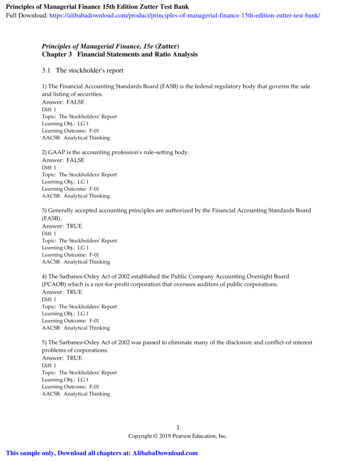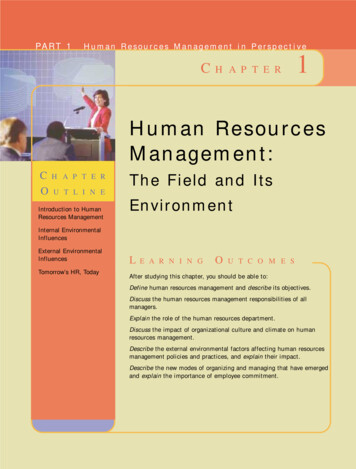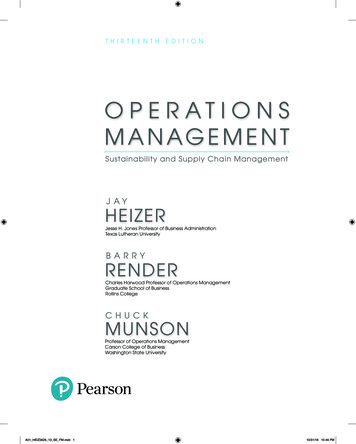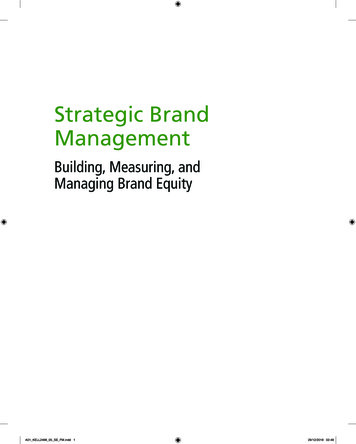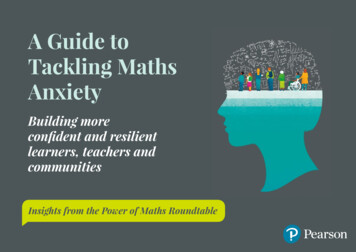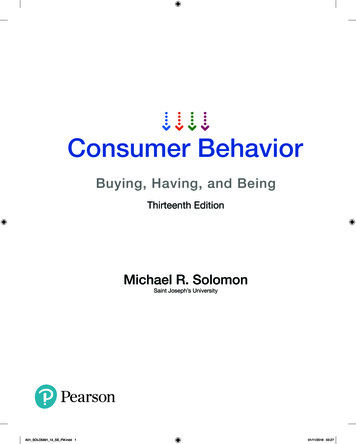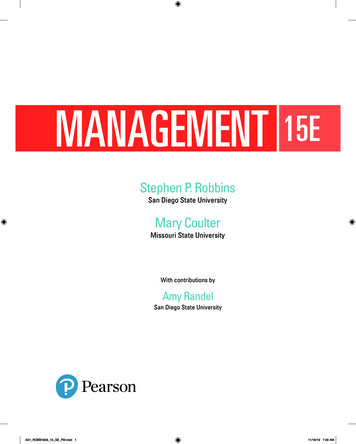
Transcription
MANAGEMENT 15EStephen P. RobbinsSan Diego State UniversityMary CoulterMissouri State UniversityWith contributions byAmy RandelSan Diego State UniversityA01 ROBB1858 15 SE FM.indd 111/18/19 7:48 AM
Please contact pport with any queries on this content.Copyright 2021, 2018, 2016 by Pearson Education, Inc. or its affiliates, 221 River Street, Hoboken, NJ 07030.All Rights Reserved. Manufactured in the United States of America. This publication is protected by copyright, andpermission should be obtained from the publisher prior to any prohibited reproduction, storage in a retrieval system, ortransmission in any form or by any means, electronic, mechanical, photocopying, recording, or otherwise. For informationregarding permissions, request forms, and the appropriate contacts within the Pearson Education Global Rights andPermissions department, please visit www.pearsoned.com/permissions/.Acknowledgments of third-party content appear on the appropriate page within the text.PEARSON, ALWAYS LEARNING, and MYLAB are exclusive trademarks owned by Pearson Education, Inc. or itsaffiliates in the U.S. and/or other countries.Unless otherwise indicated herein, any third-party trademarks, logos, or icons that may appear in this work are theproperty of their respective owners, and any references to third-party trademarks, logos, icons, or other trade dress arefor demonstrative or descriptive purposes only. Such references are not intended to imply any sponsorship, endorsement,authorization, or promotion of Pearson’s products by the owners of such marks, or any relationship between the ownerand Pearson Education, Inc., or its affiliates, authors, licensees, or distributors.Library of Congress Cataloging-in-Publication DataNames: Robbins, Stephen P., author. Coulter, Mary K., author.Title: Management / Stephen P. Robbins, Mary Coulter.Description: 15 Edition. Hoboken, NJ : Pearson, [2020] Revised editionof the authors’ Management, [2018]Identifiers: LCCN 2019020717 (print) LCCN 2019980991 (ebook) ISBN 9780135581858 ISBN 9780135581872 (ebook other)Subjects: LCSH: Management.Classification: LCC HD31 .R5647 2020 (print) LCC HD31 (ebook) DDC 658—dc23LC record available at https://lccn.loc.gov/2019020717LC ebook record available at CodeISBN 10: 0-13-558185-0ISBN 13: 978-0-13-558185-8A01 ROBB1858 15 SE FM.indd 211/18/19 7:48 AM
To my wife, LauraSteveTo my husband, RonMaryA01 ROBB1858 15 SE FM.indd 311/18/19 7:48 AM
A01 ROBB1858 15 SE FM.indd 411/18/19 7:48 AM
Brief ContentsPrefacexxiiiAcknowledgmentsxxxiPart 1 Introduction to ManagementChapter 1: Managers and You in the WorkplaceManagement History Module22Chapter 2: Making Decisions3622Part 1 Management Practice 58Part 2 Basics of Managing in Today’s Workplace 62Chapter 3: Influence of the External Environment and the Organization’s CultureChapter 4: Managing in a Global EnvironmentChapter 5: Managing Diversity6284108Chapter 6: Managing Social Responsibility and EthicsChapter 7: Managing Change and Disruptive Innovation136162Part 2 Management Practice 194Part 3 Planning 200Chapter 8: Foundations of PlanningChapter 9: Managing Strategy200220Chapter 10: Entrepreneurial Ventures 244Part 3 Management Practice 270Part 4 Organizing 274Chapter 11: Designing Organizational Structure 274Chapter 12: Managing Human Resources300Chapter 13: Managing Groups and Teams332Part 4 Management Practice 356Part 5 Leading 360Chapter 14: Managing Communication360Chapter 15: Understanding and Managing Individual BehaviorChapter 16: Motivating Employees382416Chapter 17: Being an Effective Leader 448Part 5 Management Practice 480Part 6 Controlling484Chapter 18: Monitoring and Controlling484Planning and Control Techniques ModuleManaging Operations Module514530Part 6 Management Practice 542Glossary 546 Name Index 557 Organization Index 571 Subject Index 575A01 ROBB1858 15 SE FM.indd 5v11/18/19 7:48 AM
ContentsPreface xxiiiAcknowledgments xxxiPart 1 Introduction to Management2Chapter 1: Managers and You in the Workplace2Tell Who Managers Are and Where They Work 2Who Is a Manager?2Where Do Managers Work?3Why Are Managers Important?4Management Versus Managers5What Is Management? 5What Do Managers Do?6Managerial Challenges Today and Into the Future8Focus on Technology 8Focus on Disruptive InnovationFocus on Social MediaFocus on Ethics9911Focus on Political UncertaintyFocus on the Customer1111Why Study Management? 12The Universality of ManagementThe Reality of Work1212Rewards from Being a Manager 13Gaining Insights into Life at Work13Employability Skills 13Boxed FeaturesFYI 4, 11It’s Your Career: The ABC’s of Managing Your Time 9Learning from Failure: Successful Managers Learn from Their FailuresWorkplace Confidential: Dealing with Organizational Politics 14Preparing For: Exams/Quizzes16Chapter Summary by Learning ObjectivesReview and Discussion QuestionsPreparing For: My CareerEthics Dilemma1016171717Skill Exercise: Developing Your Skills as a Manager 18Working Together: Team Exercise 18My Turn to Be a Manager18viA01 ROBB1858 15 SE FM.indd 611/18/19 7:48 AM
ContentsCase Application 1: Working with Artificial Intelligence19Case Application 2: Nike: Taking a Customer Focus to a New LevelManagement History ModuleEarly Managementvii202222Classical Approach 23Scientific Management23General Administrative Theory25Behavioral Approach 27Quantitative Approach 29Contemporary Approaches30Preparing For: Exams/Quizzes33Chapter Summary by Learning Objectives 33Review and Discussion Questions34Preparing For: My Career 34My Turn to Be a Manager34Chapter 2: Making DecisionsThe Decision-Making ProcessStep 1: Identify a Problem363737Step 2: Identify Decision Criteria38Step 3: Allocate Weights to the Criteria 38Step 4: Develop Alternatives39Step 5: Analyze Alternatives39Step 6: Select an Alternative40Step 7: Implement the Alternative40Step 8: Evaluate Decision EffectivenessApproaches to Decision MakingRationality4041Bounded RationalityIntuition404142Evidence-Based ManagementCrowdsourcingTypes of Decisions424344Structured Problems and Programmed Decisions44Unstructured Problems and Nonprogrammed DecisionsComparing Decision TypesDecision-Making Styles444545Decision-Making Biases and Errors 47Cutting-Edge Approaches for Improving Decision Making 48Design Thinking48Big Data and Artificial Intelligence50Boxed FeaturesFYI 37, 43, 48, 51Let’s Get REAL 43Learning from Failure: James Dyson: A Man of a Thousand FailuresWorkplace Confidential: Making Good Decisions 49A01 ROBB1858 15 SE FM.indd 74611/18/19 7:48 AM
viii ContentsPreparing For: Exams/Quizzes51Chapter Summary by Learning Objectives 51Review and Discussion QuestionsPreparing For: My CareerEthics Dilemma525353Skills Exercise: Developing Your Creativity Skill 53Working Together: Team Exercise 54My Turn to Be a Manager54Case Application 1: Making Decisions with Bad Data 54Case Application 2: Bringing Sports Analytics into the Thick of Things55Part 1: Management Practice 58A Manager’s DilemmaGlobal Sense5858Continuing Case: Starbucks—Introduction58Part 2 Basics of Managing in Today’s Workplace62Chapter 3: Influence of the External Environmentand the Organization’s Culture 62The Manager: Omnipotent or Symbolic?The Omnipotent ViewThe Symbolic View636363Reality Suggests a Synthesis 64The External Environment: Constraints and Challenges64Defining the Environment and Environmental UncertaintyMonitoring the General EnvironmentThe Specific Environment6667Managing the Environment69Organizational Culture: Constraints and ChallengesWhat Is Organizational Culture?Strong Cultures64697071Where Culture Comes From and How It ContinuesHow Employees Learn Culture73How Culture Affects Managers7772Boxed FeaturesLet’s Get REAL 66, 73FYI 67, 70Learning from Failure: A Corrupt Culture at Wells Fargo 74It’s Your Career: Reading an Organization’s Culture: Find One That Is a Right Fit for YouWorkplace Confidential: Adjusting to a New Job or Work Team 76Preparing For: Exams/Quizzes7578Chapter Summary by Learning Objectives 78Review and Discussion QuestionsPreparing For: My CareerEthics Dilemma797979Skill Exercise: Developing Your Environmental Scanning SkillA01 ROBB1858 15 SE FM.indd 87911/18/19 7:48 AM
ContentsixWorking Together: Team Exercise 80My Turn to Be a Manager80Case Application 1: Environmental Uncertainty at HBO 80Case Application 2: Organizational Culture at Vice Media 81Chapter 4: Managing in a Global Environment84Clarifying Terminology 85A Brief History of Globalization86The Case For and Against GlobalizationThe Win-Win ArgumentThe Downside of GlobalizationGlobalization Today90909091What Does This Mean for Managers?91Different Types of International OrganizationsHow Organizations Go International93Managing in a Global EnvironmentThe Political/Legal EnvironmentThe Economic EnvironmentThe Cultural Environment9294949596Boxed FeaturesFYI 88, 90, 96Let’s Get REAL 95It’s Your Career: Developing Your Global Perspective—Working with People from Other CulturesLearning from Failure: Disney Learns That France Isn’t Florida 100Preparing For: Exams/Quizzes96100Chapter Summary by Learning Objectives 100Review and Discussion Questions102Preparing For: My Career 102Ethics Dilemma102Skills Exercise: Developing Your Collaboration SkillWorking Together: Team ExerciseMy Turn to Be a Manager103103103Case Application 1: Glencore: Conducting Business in Countries Where Others Might Not 104Case Application 2: Tariffs: Helping or Hurting General Motors? 105Chapter 5: Managing Diversity108Diversity 101 109What Is Workplace Diversity?109Benefits of Workforce Diversity 110The Changing Workplace112Characteristics of the US Population112What About Global Workforce Changes? 115Types of Workplace DiversityAge115Gender116Race and EthnicityA01 ROBB1858 15 SE FM.indd 911511711/18/19 7:48 AM
xContentsDisabilitiesReligion118119LGBT: Sexual Orientation and Gender IdentityChallenges in Managing DiversityPersonal Bias120Glass Ceiling122Pay Inequities120122Workplace Diversity Initiatives123Top Management Commitment to DiversityMentoring120123124Diversity Training 125Employee Resource Groups125Some Final Thoughts and Questions126Boxed FeaturesFYI 111, 121, 122, 124Let’s Get REAL 112, 118Workplace Confidential: Dealing with Diversity 113Learning from Failure: Denny’s Answer to Its Diversity ProblemPreparing For: Exams/Quizzes124126Chapter Summary by Learning Objectives 126Review and Discussion QuestionsPreparing For: My CareerEthics Dilemma127128128Skills Exercise: Developing Your Valuing Diversity Skill 128Working Together: Team Exercise 129My Turn to Be a Manager129Case Application 1: Gusto: Making a Difference in Gender DiversityCase Application 2: Bring in Diversity . . . and Then What?129130Chapter 6: Managing Social Responsibilityand Ethics 136What is Social Responsibility?Two Opposing Views137137From Obligations to Responsiveness to ResponsibilitySocial Responsibility and Economic PerformanceGreen Management and Sustainability139139140How Organizations Go Green 140Evaluating Green Management ActionsManagers and Ethical Behavior141142Factors That Determine Ethical and Unethical Behavior143Ethics in an International Context 146Encouraging Ethical Behavior 148Employee SelectionCodes of Ethics148149Leadership at the Top149Job Goals and Performance AppraisalEthics Training150Independent Social AuditsA01 ROBB1858 15 SE FM.indd 1015015111/18/19 7:48 AM
ContentsCurrent Issues in Social Responsibility and EthicsProtecting Whistle-Blowers151151Promoting Social Entrepreneurship151Social Media and Social ResponsibilityCorporate Philanthropyxi152152Boxed FeaturesFYI 140, 141, 144, 145, 151Let’s Get REAL 142, 148Learning from Failure: Siemens Atones for Its Sins 147Workplace Confidential: Balancing Work and Personal LifePreparing For: Exams/Quizzes153154Chapter Summary by Learning Objectives 154Review and Discussion Questions155Preparing For: My Career 156Ethics Dilemma156Skills Exercise: Developing Your Trust Building Skill 156Working Together: Team ExerciseMy Turn to Be a Manager157157Case Application 1: Chobani: A Different Kind of Yogurt Company 157Case Application 2: Every Kid Fed: Addressing Childhood Hunger Through Social EntrepreneurshipChapter 7: Managing Change and Disruptive InnovationThe Case for ChangeLiving with VUCA163164Internal Forces for Change165The Change Process165The Calm Waters Metaphor166The White-Water Rapids ple162163External Forces for ChangeAreas of Change158169169Managing Change170Why Do People Resist Change?170Techniques for Reducing Resistance to Change170Contemporary Issues in Managing Change 172Changing an Organization’s CultureEmployee Stress172173Stimulating Innovation177Creativity Versus Innovation177Stimulating and Nurturing Innovation177Disruptive Innovation 180Definition180Why Disruptive Innovation Is ImportantWho’s Vulnerable?ImplicationsA01 ROBB1858 15 SE FM.indd 1118018118211/18/19 7:48 AM
xiiContentsBoxed FeaturesFYI 164, 170, 174, 181Let’s Get REAL 171, 179Workplace Confidential: Coping with Job StressPreparing For: Exams/Quizzes176184Chapter Summary by Learning Objectives 184Review and Discussion QuestionsPreparing For: My CareerEthics Dilemma185185185Skills Exercise: Developing Your Change-Management Skill186Working Together: Team Exercise 187My Turn to Be a Manager187Case Application 1: Change from Within at Google187Case Application 2: Creating an Innovation Lab at Neiman Marcus188Part 2: Management Practice 194A Manager’s DilemmaGlobal Sense194194Continuing Case Starbucks—Basics of Managing In Today’s WorkplacePart 3 Planning194200Chapter 8: Foundations of PlanningThe What and Why of PlanningWhat Is Planning?200201201Why Do Managers Plan?201Planning and Performance 202Types of Plans203Strategic Versus Operational Plans203Short-Term Versus Long-Term Plans 203Specific Versus Directional Plans204Single-Use Versus Standing Plans204Contingency Factors in Planning 205Level in the Organization205Degree of Environmental Uncertainty205Length of Future Commitments 205Objectives: The Foundation of PlanningStated Versus Real ObjectivesTraditional Objective SettingManagement by Objectives206206207208Contemporary Issues in Planning211Environmental Scanning 211Virtual Reality212Boxed FeaturesLet’s Get REAL 202FYI 204, 209, 211A01 ROBB1858 15 SE FM.indd 1211/18/19 7:48 AM
ContentsLearning from Failure: US Army Corps of Engineers and Hurricane KatrinaWorkplace Confidential: When You Face a Lack of Clear Directions 210Preparing For: Exams/Quizzesxiii206212Chapter Summary by Learning Objectives 212Review and Discussion Questions213Preparing For: My Career 214Ethics Dilemma214Skills Exercise: Making a To-Do List That Works and Using It214Working Together: Team Exercise 215My Turn to Be a Manager215Case Application 1: Capturing Anti-Trends at New Balance 215Case Application 2: Living Up to Goals at Tesla216Chapter 9: Managing Strategy220What Is Strategic Management and Why Is It Important?Defining Strategic Management221221Why Is Strategic Management Important?The Strategic Management Process222222Step 1: Identifying the Organization’s Current Mission, Goals, and StrategiesStep 2: Doing an External Analysis224Step 3: Doing an Internal Analysis224Step 4: Formulating Strategies225Step 5: Implementing StrategiesStep 6: Evaluating ResultsCorporate Strategies223225225226What Is Corporate Strategy?228What Are the Types of Corporate Strategy? 228How Are Corporate Strategies Managed?Competitive Strategies229230The Role of Competitive AdvantageSustaining Competitive Advantage230231Examples of Differentiation Strategies232Boxed FeaturesFYI 223, 233, 235Let’s Get REAL 225It’s Your Career: Learning Your Strengths and Weaknesses 226Workplace Confidential: Developing a Career Strategy 227Learning from Failure: Coke Panics After the Pepsi Challenge 230Preparing For: Exams/Quizzes235Chapter Summary by Learning Objectives 235Review and Discussion Questions236Preparing For: My Career 237Ethics Dilemma237Skills Exercise: Developing Your Business Planning Skill 237Working Together: Team ExerciseMy Turn to Be a Manager238238Case Application 1: Turnaround at Chipotle 239Case Application 2: Saving Lives Through Strategy at RapidSOS 239A01 ROBB1858 15 SE FM.indd 1311/18/19 7:48 AM
xiv ContentsChapter 10: Entrepreneurial VenturesThe Context of EntrepreneurshipWhat Is Entrepreneurship?244245245Why Is Entrepreneurship Important?The Entrepreneurial Process246What Do Entrepreneurs Do?246245A Hybrid Path to Entrepreneurship 247Start-Up and Planning Issues247Identifying Environmental Opportunities and Competitive AdvantageResearching the Venture’s Feasibility—IdeasResearching the Venture’s Feasibility—CompetitorsResearching the Venture’s Feasibility—FinancingDeveloping a Business Plan249250252253253Organizing Issues 254Legal Forms of Organization255Organizational Design and StructureHuman Resource Management257258Leading Issues 258Personality Characteristics of Entrepreneurs259The Entrepreneur as Leader 259Control Issues 261Potential Control Problems and ActionsExiting the Venture261261Boxed FeaturesWorkplace Confidential: Dealing with Risks 248FYI 249, 252, 253Let’s Get REAL 251, 254Learning from Failure: The Third Time Is a Charm for Vera WangPreparing For: Exams/Quizzes260262Chapter Summary by Learning Objectives 262Review and Discussion QuestionsPreparing For: My CareerEthics Dilemma263263263Skills Exercise: Developing Grit 263Working Together: Team Exercise 264My Turn to Be a Manager264Case Application 1: Becoming an Entrepreneur While In College with Brainz Power 265Case Application 2: Qordoba: How Sweet It Is to Find a Solution to a Problem 266Part 3: Management Practice 270A Manager’s DilemmaGlobal Sense270270Continuing Case Starbucks—PlanningA01 ROBB1858 15 SE FM.indd 1427111/18/19 7:48 AM
ContentsPart 4 Organizing274Chapter 11: Designing Organizational StructureSix Elements of Organizational DesignWork Specialization275Departmentalization277Chain of CommandSpan of Control274275277279Centralization and DecentralizationFormalizationxv281282Mechanistic and Organic Structures 283Contingency Factors Affecting Structural ChoiceStrategy and Structure283284Size and Structure 284Technology and Structure 284Environmental Uncertainty and Structure 284Traditional Organizational Design OptionsSimple Structure285285Functional Structure 286Divisional Structure286Organizing for Flexibility in the Twenty-First CenturyTeam StructuresMatrix and Project StructuresThe Virtual OrganizationTelecommuting287287288Compressed Work WeeksFlextime286287289290Job Sharing290The Contingent Workforce 291Boxed FeaturesLet’s Get REAL 279, 289Workplace Confidential: Coping with Multiple Bosses 280FYI 281, 288, 288, 291Learning from Failure: Working at Home Doesn’t Work at IBMPreparing For: Exams/Quizzes290292Chapter Summary by Learning Objectives 292Review and Discussion Questions293Preparing For: My Career 293Ethics Dilemma293Skills Exercise: Developing Your Acquiring Power SkillWorking Together: Team ExerciseMy Turn to Be a Manager293294294Case Application 1: Making a Flat Organization Work at Punchkick 295Case Application 2: The Invisible Workforce at GoogleA01 ROBB1858 15 SE FM.indd 1529611/18/19 7:48 AM
xvi ContentsChapter 12: Managing Human Resources 300Why Human Resource Management Is ImportantThe Human Resource Management Process301302External Factors That Affect the Human Resource Management Process 302The Economy302Labor Unions303Laws and RulingsDemography303305Identifying and Selecting Competent EmployeesHuman Resource PlanningRecruitment and DecruitmentSelection306306307309Providing Employees With Needed Skills and KnowledgeOrientation and SocializationEmployee Training314Retaining Competent, High-Performing EmployeesPerformance Evaluation315315Compensation and BenefitsCareer Development312312317320Contemporary Issues in Managing Human Resources 320Sexual Harassment 320Bullying in the Workplace321Boxed FeaturesWorkplace Confidential: Job Search 308FYI 309, 314, 315, 319Let’s Get REAL 312, 318Learning from Failure: Forced Rankings Bomb at MicrosoftPreparing For: Exams/Quizzes317322Chapter Summary by Learning Objectives 322Review and Discussion QuestionsPreparing For: My CareerEthics Dilemma324324324Skills Exercise: Developing Your Interviewing Skills324Working Together: Team Exercise 325My Turn to Be a Manager325Case Application 1: “Moneyball for HR” at Unilever 326Case Application 2: Keeping Dealership Sales Staff from Leaving at Nissan327Chapter 13: Managing Groups and Teams 332Groups and Group DevelopmentWhat Is a Group?333333Stages of Group Development333Work Group Performance and SatisfactionExternal Conditions Imposed on the GroupGroup Member ResourcesGroup StructureA01 ROBB1858 15 SE FM.indd 1633533533533511/18/19 7:48 AM
ContentsGroup ProcessesGroup Tasksxvii339341Turning Groups into Effective Teams342The Difference Between Groups and TeamsTypes of Work Teams342342Creating Effective Work Teams345Boxed FeaturesFYI 333, 343, 345Let’s Get REAL 341, 346It’s Your Career: Maximizing Outcomes Through NegotiationWorkplace Confidential: Handling Difficult Coworkers 347Preparing For: Exams/Quizzes344348Chapter Summary by Learning Objectives 348Review and Discussion Questions349Preparing For: My Career 349Ethics Dilemma349Skills Exercise: Developing Your Coaching Skills349Working Together: Team Exercise 350My Turn to Be a Manager350Case Application 1: Making Delivery Drones a Reality at AlphabetCase Application 2: “Remote Week” at HubSpot350351Part 4: Management Practice 356A Manager’s Dilemma356Global Sense 356Continuing Case Starbucks—OrganizingPart 5 Leading356360Chapter 14: Managing Communication 360Understanding CommunicationWhat Is Communication?361361Functions of CommunicationThe Communication ProcessModes of Communicating361362362Barriers to Effective CommunicationOvercoming the Barriers363365Effective Organizational Communication 368Formal Versus InformalDirection of FlowNetworks368368369Communication in the Internet and Social Media Age 370The 24/7 Work Environment371Social Media 371CybersecurityA01 ROBB1858 15 SE FM.indd 1737211/18/19 7:48 AM
xviii ContentsBecoming a Better Communicator373Sharpening Your Persuasion SkillsSharpening Your Speaking Skills373373Sharpening Your Writing Skills 373Sharpening Your Reading Skills 374Boxed FeaturesIt’s Your Career: I’m Listening! 366Let’s Get REAL 366, 370Workplace Confidential: An Uncommunicative Boss 367FYI 369, 370, 372, 373Learning from Failure: GM’s Catastrophic Communications BreakdownPreparing For: Exams/Quizzes371374Chapter Summary by Learning Objectives 374Review and Discussion QuestionsPreparing For: My CareerEthics Dilemma375375375Skills Exercise: Developing Your Presentation Skills375Working Together: Team Exercise 376My Turn to Be a Manager376Case Application 1: Communicating as the Company Grows at HootsuiteCase Application 2: Communication Challenge at Facebook377378Chapter 15: Understanding and Managing Individual BehaviorFocus and Goals of Organizational BehaviorFocus of Organizational Behavior383Goals of Organizational Behavior384Attitudes and Job Performance382383384Job Satisfaction 385Job Involvement and Organizational CommitmentEmployee Engagement386387Attitudes and Consistency387Cognitive Dissonance Theory 388Attitude Surveys388Implications for ManagersPersonality389389MBTI 389The Big Five ModelThe Dark Triad391392Additional Personality Insights393Personality Types in Different CulturesEmotions and Emotional IntelligenceImplications for ManagersPerception394395397398Factors That Influence PerceptionAttribution Theory399399Shortcuts Used in Judging Others 401Implications for ManagersA01 ROBB1858 15 SE FM.indd 1840211/18/19 7:48 AM
ContentsLearningxix402Operant ConditioningSocial Learning402403Shaping: A Managerial ToolImplications for Managers403404Boxed FeaturesFYI 385, 388, 390, 392, 397Let’s Get REAL 391, 395Workplace Confidential: An Abusive BossPreparing For: Exams/Quizzes396404Chapter Summary by Learning Objectives 404Review and Discussion Questions406Preparing For: My Career 406Ethics Dilemma406Skills Exercise: Developing Your Shaping Behavior Skill 406Working Together: Team Exercise 407My Turn to Be a Manager407Case Application 1: Employee Experience at IBM 408Case Application 2: Getting Your Company’s Logo as a TattooChapter 16: Motivating EmployeesWhat is Motivation?409416417Early Theories of Motivation418Maslow’s Hierarchy of Needs Theory 418McGregor’s Theory X and Theory Y 419Herzberg’s Two-Factor Theory 419Three-Needs Theory 420Contemporary Theories of MotivationGoal-Setting Theory421Reinforcement Theory422Designing Motivating JobsEquity Theory421423426Expectancy Theory427Integrating Contemporary Theories of MotivationCurrent Issues in Motivation430432Managing Cross-Cultural Motivational ChallengesMotivating Unique Groups of Workers432434Designing Appropriate Rewards Programs 435Boxed FeaturesIt’s Your Career: What Motivates You? 417FYI 422, 423, 436Workplace Confidential: Feelings of Unfair Pay 428Let’s Get REAL 432, 437Learning from Failure: NSPS: Pay-for-Performance Gone BadPreparing For: Exams/Quizzes438438Chapter Summary by Learning Objectives 438Review and Discussion QuestionsA01 ROBB1858 15 SE FM.indd 1944011/18/19 7:48 AM
xxContentsPreparing For: My CareerEthics Dilemma440440Skills Exercise: Developing Your Motivating Employees Skill440Working Together: Team Exercise 441My Turn to Be a Manager441Case Application 1: Motivating Employees Who Love the Outdoors at REI441Case Application 2: Motivating Under Constraints at Televerde 442Chapter 17: Being an Effective LeaderWho Are Leaders, and What Is Leadership?Early Leadership TheoriesLeadership Traits448449449449Leadership Behaviors450Contingency Theories of LeadershipThe Fiedler Model452452Hersey and Blanchard’s Situational Leadership TheoryPath-Goal Model454455Contemporary Views of Leadership 457Leader–Member Exchange (LMX) TheoryCharismatic Leadership457457Transformational-Transactional LeadershipAuthentic LeadershipEthical Leadership459Servant LeadershipFollowership458459460460Integrating Theories of Leadership 461Leadership Issues in the Twenty-First CenturyManaging Power463463Developing Credibility and Trust 463Leading Virtual Teams 466Leadership Training467When Leadership May Not Be Important468Boxed FeaturesFYI 458, 463, 468Learning from Failure: The Firing of Steve Jobs at AppleLet’s Get REAL 462, 466Workplace Confidential: A Micromanaging Boss 464It’s Your Career: How to Be Seen as Trustworthy 465Preparing For: Exams/Quizzes459468Chapter Summary by Learning Objectives 468Review and Discussion QuestionsPreparing For: My CareerEthics Dilemma470470470Skills Exercise: Choosing an Effective Group Leadership Style Skill 470Working Together: Team Exercise 471My Turn to Be a Manager471Case Application 1: Transforming the Fashion Industry at Stitch Fix472Case Application 2: Recognizing What Leadership Is Needed at the Golden State WarriorsA01 ROBB1858 15 SE FM.indd 2047311/18/19 7:48 AM
ContentsxxiPart 5: Management Practice 480A Manager’s Dilemma480Global Sense 480Continuing Case Starbucks—LeadingPart 6 Controlling480484Chapter 18: Monitoring and ControllingWhat is Controlling, and Why is it Important?What Is Controlling?485485Why Is Controlling Important?The Control Process485486Step 1: Measuring Actual Performance486Step 2: Comparing Actual Performance Against the StandardStep 3: Taking Managerial ActionSummary484488489490Controlling for Organizational and Employee PerformanceWhat Is Organizational Performance?490490Measures of Organizational PerformanceControlling for Employee Performance491493Tools for Measuring Organizational Performance 493Feedforward/Concurrent/Feedback ControlsFinancial Controls495496Information ControlsBalanced Scorecard497499Benchmarking of Best PracticesContemporary Issues in Control499500Social Media as a Control Tool 500Global Differences in ControlWorkplace PrivacyEmployee Theft501501502Corporate Governance503Boxed FeaturesIt’s Your Career: How to Be a Pro at Giving Feedback 492FYI 493, 501Workplace Confidential: Responding to an Unfair Performance ReviewLet’s Get REAL 495, 498Preparing For: Exams/Quizzes494504Chapter Summary by Learning Objective 504Review and Discussion Questions506Preparing For: My Career 506Ethics Dilemma506Skills Exercise: Managing Challenging Employees506Working Together: Team Exercise 507My Turn to Be a Manager507Case Application 1: Bug Bounty Hackers at General Motors 508Case Application 2: Posting for Just Other Employees to See 509A01 ROBB1858 15 SE FM.indd 2111/18/19 7:48 AM
xxii ContentsPlanning and Control Techniques ModuleTechniques for Assessing the Environment514514Environmental Scanning 514Forecasting516Techniques for Allocating Resources 517BudgetingScheduling518519Breakeven Analysis522Linear Programming523Contemporary Planning Techniques525Project Management 525Scenario Planning526Review and Discussion Questions527Managing Operations ModuleThe Role of Operations Management530530Services and Manufacturing 530Managing Productivity531Strategic Role of Operations ManagementValue Chain Management532What is Value Chain Management?Goal of Value Chain Management533533Benefits of Value Chain ManagementValue Chain Strategy532534534Current Issues in Managing Operations536Technology’s Role in Operations ManagementThe Robots Are Coming!Quality ManagementQuality Goals536537537538Mass Customization539Creating a Lean Organization539Review and Discussion Questions540Part 6: Management Practice 542A Manager’s DilemmaGlobal Sense542542Continuing Case Starbucks—Controlling542Glossary 546Name Index 557Organization Index 571Subject Index 575A01 ROBB1858 15 SE FM.indd 2211/18/19 7:48 AM
PrefaceWelcome to the 15th edition of Management. First published in 1984, this book hasbecome one of the world’s most popular introd
v Preface xxiii Acknowledgments xxxi Part 1 Introduction to Management 2 Chapter 1: Managers and You in the Workplace 2 Management History Module 22 Chapter 2: Making Decisions 36 Part 1 Management Practice 58 Part 2 Basics of Managing in Today’s Workplace 62 Chapter 3: Influence of the External Environmen
